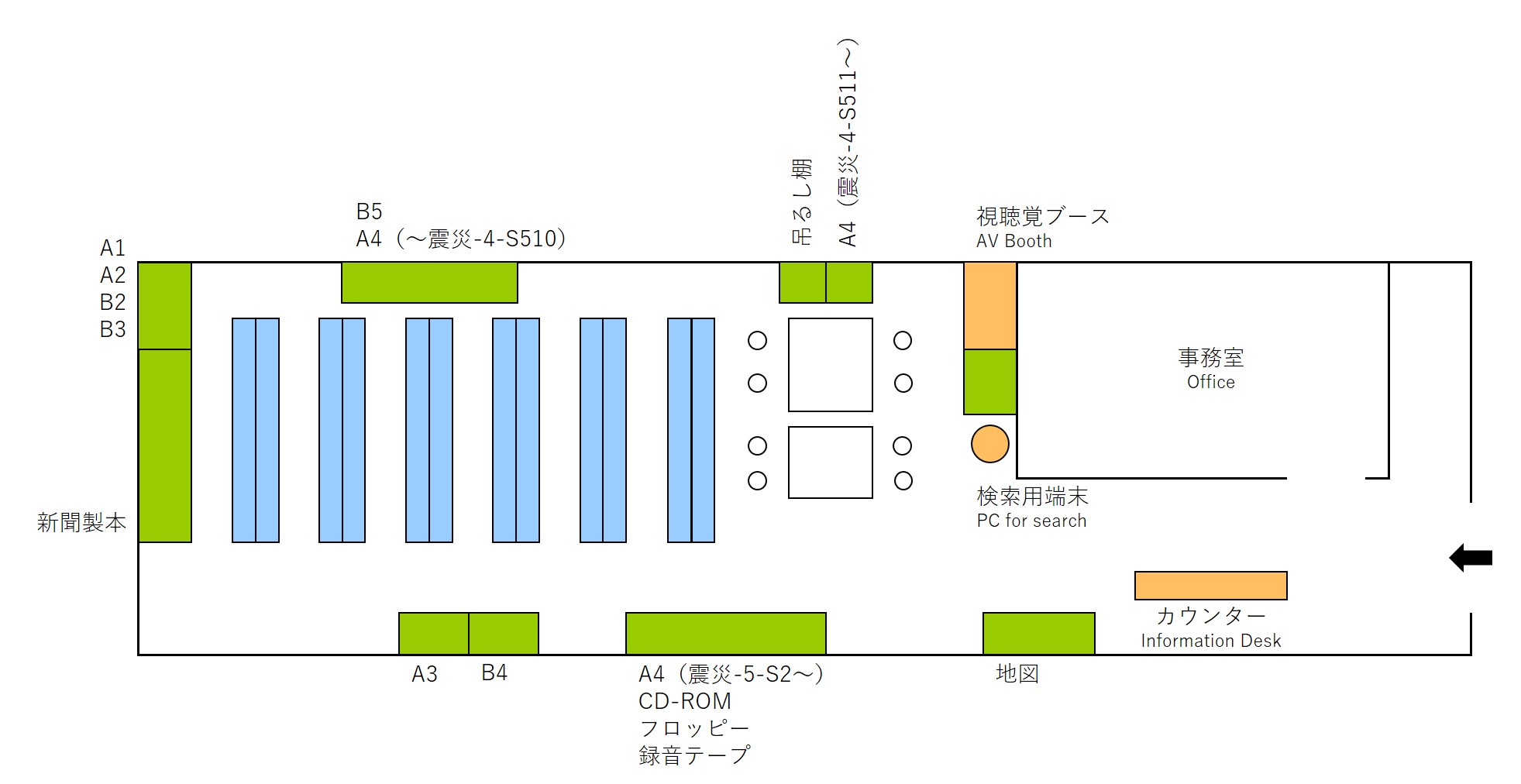Floor Map
Library for Social Sciences 3F

About Call Number
All materials in EDMC assigned the call number, like “震災-4-15”.
These numbers mean classification of materials to some extent and sorting order in the shelves that are required to pick up the material.
Book Mark
The last part following class number “15” of “震災-4-15” is the Book Mark.
These are numbers of series in the order of accession. As well as composed only figure, some materials added alphabet like “震災-4-s15”.
You can also search “Only figure” materials by Online Public Access Catalog(OPAC) of Kobe Univ.
Only figure (震災-4-15)
These materials are treated as normal books at the library. They are arranged usually on the shelf in numerical order, but maps, audiovisual materials, etc. may be placed separately on cabinets for them.
added “v” in front of figure (震災-4-v15)
For leaflets, resume, and pamphlets materials. Note that the materials that take proper form of booklets are treated as “Only figure” above.
They can be found on the shelves as well as “Only figure”.
added “s” in front of figure (震災-4-s15)
For only a few pieces of material like leaflets and posters and so forth.
As well, because these kinds of materials have a lot of difficulty to stack with normal books together, these are placed separately on cabinets of each material size. When you go to pick up these materials, please note the material size as well as the Book Mark.
added “z” in front of figure (震災-4-z15)
The materials run articles about Earthquake Disaster in the parts of magazines.
They can be found on the shelves as well as “Only figure”.
added “n” in front of figure (震災-4-n15)
These materials are collected by volunteer association “Earthquake and activity recorded room”.
They can be found on the shelves as well as “Only figure”.
added “d” in front of figure (震災-4-d15)
For only electronic media.
Some of the materials are on the web, and some require you to apply for usage.
Class Number
For example, class number of “震災-4-15” is 4.
Materials in EDMC are classified following 16 classes regardless of the forms of books, leaflets, audio-visual data.
1. Earthquake Disasters
Reported photo collection, miniature edition of news paper, Special edition magazine, Recorded photo collection, aerial photograph, newsflash, Map (Earthquake-striken area / Habitation map), General study
2. Law
3. Economy
Economic forecast, Finance
4. Public Administration
Rvival project, neighborhood association, Residents’ assoication, Rezoning, publicity work, environment, a taxation system, a land price, the police, a proposal, crisis management
5. Fire Service / Disaster Prevention
Disaster relief, emergency activity, Self-Defense-Forces activity, a disaster prevention (survival) manual, a shelter
6. Citizen Lives
An opinion poll, a consumer’s issue, the housing problem, women’s issues, a proposal, crisis management
7. Social Welfare
A volunteer, a disabled person problem, a contribution
8. Education
the open class of a general earthquake, citizens college, and seminar, secondary reader, a foreign student, library news, and the crisis management of a school
9. Earthquake / Ground Viberation
Earthquake engineering, an active fault, a geologic map and a topographical map, earthquake prediction
10. Medical Care
Emergency medical treatment, nursing, moral medical care
11. Civil Engineering / Architecture
Design engineering, a lifeline (electricity, gas, and water service), liquefaction
12. Industry / Physical Distribution
Agriculture, industry, commerce, fisheries, a specific local industry, an employment problem, a company (including crisis management), trade
13. Traffic / Harbor
sight seeing
14. Information / Communications
media, publication, a report, personal computer communications
15. Art / Cultural Heritage
16.Literature
The account of a hand, the collection of compositions, a literary work, school-related collection of works

